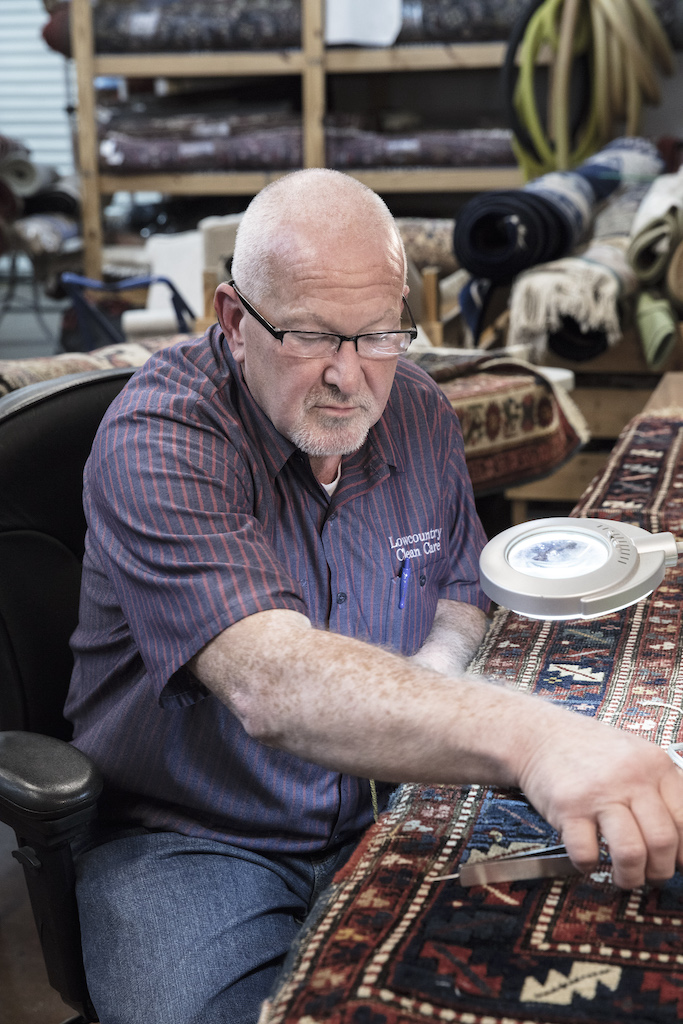For example, those fibers which weave in and out of each piece, forming dazzling eye-catching patterns when viewed from afar, are scaly when viewed up close. Those scales actually help protect the wool from damage and can easily be damaged if not treated properly.
Say, if you were to use a high alkaline cleaning detergent, as most places do. One rinse with that and those scales are gone. “It’s all downhill from there,” said Gerald Brant, owner of Lowcountry Clean Care. “It’s going to look clean, but your rug is not going to last as long because they have degraded your rug.”
This one surprise, concealed to all save for those willing to look close enough, is just one example of the vast knowledge Brant has amassed in his long career. Starting out working mostly in recovery (smoke and fire damage, water damage, etc.), he found himself immersed more and more in the cleaning and care of rugs as Lowcountry Clean Care expanded. Today, he can look at a rug and not only know exactly how to clean it, but exactly how not to clean it.
When it comes to rugs, he’s forgotten more than most people will know. Back in 2011, he became certified as a Master Rug Cleaner through the Association of Rug Care Specialists (ARCS). Now, he can tell you about natural dyes, hand-spun wool, cotton blends, the different techniques used to make rugs and the history behind each type. But perhaps more important, he can tell you how to care for them and how to avoid ruining them.
“Something that sets me apart is that if I get a rug that has been cleaned by someone else and the rug has bled, I know what to do with that,” he said. “I may not be able to get it all out, but a lot of times I can get it to where it’s very usable.”
It’s all accomplished at his state-of-the-art facility in Hampton, where he receives rugs in all states of dirt and disrepair. Dropped off by customers at either the Clothes Press location on Hilton Head Island; at Door 2 Door Dry Cleaning Service or Gilman Floors in Bluffton; or at FWDG in Beaufort or personally picked up by Brant or one of his staff, rugs are first treated in a bath of pure rainwater.
“Rainwater is softer than tap water and gentler on the rugs,” Brant said. Providing this water is a sophisticated collection system around his facility. “During a good hard rain, we can get 1,000 gallons per inch of rain.”

After soaking in 1,200 gallons of perfectly Ph-balanced rainwater, each rug is painstakingly vacuumed with a specialized air compressor that removes even the finest sand while protecting the rug from further damage. It is then washed again, this time with giant baffles to gently agitate the rugs as they slosh in a specialized solution before being hung to dry.
If need be, Brant and his team, including key staff member John Moseley, can then repair any bare patches, threadbare spots or tears with exacting craftsmanship. “We don’t even own a sewing machine,” Brant said. “We do all of our repair work by hand. It takes time.”
It’s a painstaking process—the vacuuming alone can take up to two hours per rug—but it’s worth it to not only deliver a deep clean no matter how closely you look but to also extend the lifespan of your rug.
According to Brant, a quality Oriental rug is, “just getting broken in at 50 years. They can easily last a couple of hundred years if they’re taken care of.”
And making sure your rugs are taken care of is what Lowcountry Clean Care is all about.
To learn more, visit lowcountrycleancare.com.





